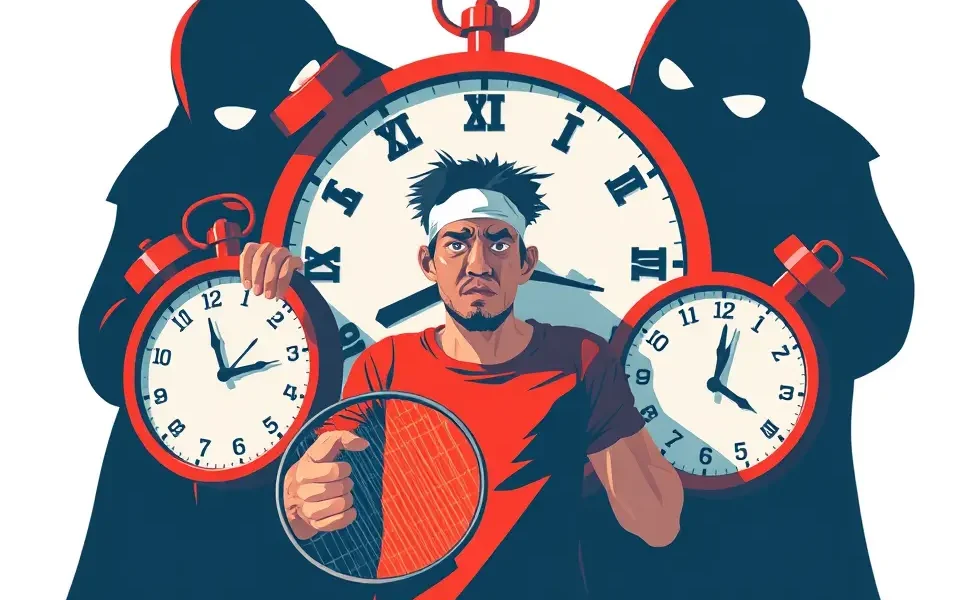Carlos Alcaraz, the world No. 2, has ignited a debate over the strict enforcement of time violation rules in tennis after a penalty during his grueling match at the Queen’s Club Championships. Alcaraz believes tennis officials need to be more tactful when penalizing players for time violations and has called for adjustments to be made to the rule. His comments came after a physically demanding match against Jaume Munar, where the Spaniard felt the time constraints hindered his ability to perform at his best.
The Contentious Call
During his match against Jaume Munar, which lasted nearly three and a half hours on a hot day in the UK, Alcaraz received a time violation halfway through the deciding set. The immediate cause was Alcaraz’s need to dry his hands between points, a necessity given the humid conditions.
Under the current ATP rules, players have 25 seconds between points. A first violation results in a warning, with subsequent violations leading to a fault for the server or a point penalty for the receiver.
Alcaraz’s frustration stemmed from the perceived lack of leniency, particularly after long, physically taxing rallies. “We’ve been playing for three hours, we finished a long point at the net; they should have a little bit of hand and give us some more time,” he argued.
Alcaraz’s Argument: A Matter of Tact and Show
Alcaraz isn’t just complaining about a personal inconvenience; he raises a point about the overall quality of the game. “There are a lot of situations where everything is slow and time is running out, and we can’t prepare for the next point,” Alcaraz explained. “When you can’t prepare in the right way for the next point, you can’t play it in the right way, so I think it’s not the best for the show (match).”
The Umpire Factor
Alcaraz didn’t shy away from suggesting that the chair umpire might have been seeking attention. “I also think it’s a problem of the chair umpire, who maybe wanted to have the limelight, but it’s a rule that should be changed.” This comment highlights the subjective element in enforcing the rule, as different umpires may interpret the guidelines differently.
Impact on Performance
Alcaraz emphasized that the rushed preparation negatively impacts the quality of play, suggesting the current rule isn’t conducive to an optimal viewing experience for fans. He said that not being able to prepare properly for the next point hurts the show.
The 25-Second Rule: A History and Purpose
The 25-second rule was introduced to reduce downtime between points, thereby improving the pace and flow of matches. Brad Drewett, former ATP Executive Chairman and President, noted in 2012 that the modification would give officials a useful tool for more consistent enforcement of the time violation rule and positively impact the flow of the match.
Evolution of the Rule
In 2012, the ATP Board of Directors approved a change where the first time violation would result in a warning, and subsequent violations would lead to a fault for the server or a point penalty for the receiver. Before this, the penalty was a warning and then a point penalty for both server and receiver.
Current Procedures
The Serve/Shot Clock is primarily used for 1st serves, with a 25-second countdown displayed on the scoreboard. If the server hasn’t started their service motion when the clock reaches zero, a violation is issued. Umpires can pause the clock if both players clearly need extra time after a long point.
Other Players’ Experiences
Alcaraz isn’t alone in his frustration. During the same match, Jaume Munar also expressed his displeasure with the speed of the shot clock. Several years ago, the 25-second shot clock rule was introduced to reduce downtime during matches. It requires players to begin play within 25 seconds after a point ends on their service games.
Past Incidents
Alcaraz has had previous issues with the shot clock. At the Miami Open, he received a time violation for failing to serve within 25 seconds after finishing a point at the net. Similarly, at the China Open, he received two time violations in the first set.
Potential Solutions and Revisions
Alcaraz’s call for more “tactful” application suggests a need for umpires to consider the context of each situation. Factors like the length of the previous rally, weather conditions, and physical demands on the players could be taken into account.
Proposed Changes
- Increased Discretion for Umpires: Allow umpires more flexibility to pause or reset the clock after extended rallies or in extreme weather conditions.
- Variable Time Limits: Implement a system where the time allowed between points varies based on rally length or other factors.
- Clearer Guidelines: Establish more precise guidelines for umpires regarding when to issue warnings, ensuring consistency in applying the rule.
The Broader Impact on Tennis
The debate around time violations touches on fundamental aspects of tennis: the balance between athleticism and strategy, the role of umpires, and the viewing experience for fans.
Balancing Pace and Player Welfare
While the shot clock aims to maintain a brisk pace, critics argue it can undermine the quality of play by rushing players, especially in physically demanding matches. Finding the right balance is crucial to preserving the integrity of the sport.
Consistency and Fairness
Ensuring consistent application of the rules is essential for fairness. Players need to know what to expect from umpires, and fans need to see a level playing field.
The Road Ahead
Carlos Alcaraz’s outspoken stance on the time violation rule is likely to spark further discussion within the tennis world. Whether it leads to concrete changes remains to be seen, but it has undoubtedly put the issue in the spotlight.
What the Future Holds
As tennis continues to evolve, adapting its rules to meet the demands of the modern game is crucial. The conversation initiated by Alcaraz is a step in that direction, prompting players, officials, and fans alike to consider how to improve the sport for everyone involved.
The ATP has shown a willingness to experiment with rule changes in the past, such as trialing the elimination of service lets on the ATP Challenger Tour. This openness suggests that Alcaraz’s concerns could lead to further evaluation and potential adjustments to the time violation rule.








No Comment! Be the first one.